Vietnamese Mossy frogs, also known as Common Mossy frogs, Tonkin bug-eyed frogs, and moss bug-eyed frogs, previously known as Kwangsi warty treefrogs, attract the attention of animal lovers and pet lovers due to their charming appearance and vibrant green colour. But are Vietnamese Mossy frogs good pets or should you avoid them as a beginner? Let’s find out.
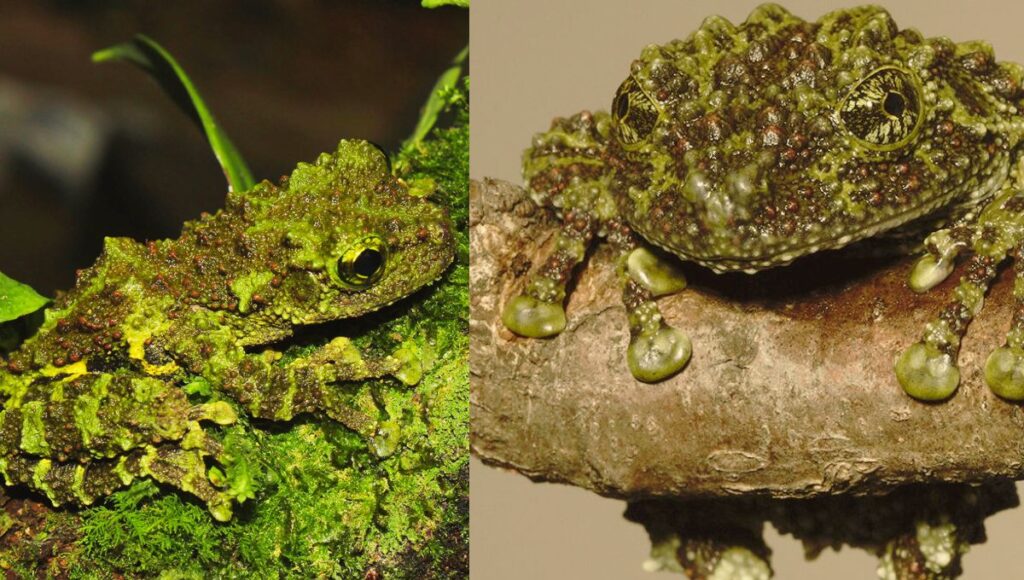
Table of Contents
Everything About Vietnamese Mossy Frogs:
In a Glimpse:
| Common Name | Mossy Frogs |
| Scientific Name | Theloderma corticale |
| Other Names | Vietnamese Mossy Frogs |
| Maximum Length | 2.4-3.6 inches |
| Maximum Weight | N/A |
| Ranges | Asia |
| Habitat | Cold and Moist Evergreen Rainforest |
| Diet | Carnivore |
| IUCN Status | Least Concern |
| Lifespan | 5-7 years |
Geographical Range:
Mossy frogs are native to Vietnam, especially northern Vietnam. They are found in south-central Laos, from the Mao Son and Tam Dao mountain ranges of northern Vietnam. The frogs are also found in patches in southern China such as Guangdong, Guangxi, Hainan, and Yunnan.
Habitat:
Vietnamese Mossy frogs are semi-aquatic animals that live in subtropical and evergreen rainforests. Mossy frogs are often found in shallow waters such as pools, temporary lakes, streams, and ponds in hollowed logs. These frogs are also found above 500- 1500 meters above sea level. Being a semi-aquatic animal, Mossy frogs are also found in caves and steep rocky cliffs. During their breeding they move towards land and breeding takes place in rock cavities or tree trunks or roots.
Physical Description: How do you identify a Vietnamese Mossy frog?
These Vietnamese frogs are known as Mossy frogs due to their mottled green or brown skins that resemble green moss grown on the rocks. The moss-like skin helps the frogs to camouflage and protect them from the predators.
Vietnamese Mossy frogs have soft underbelly and have large sticky pads on their toes. Sexual dimorphism is seen in the species and females are larger than the males. The snout-to-vent length of males is 2.4-3.2 inches (6-8.1 cm) and the females are 3.1-3.6 inches (8-9 cm) long.
Defence Mechanism: Are Mossy frogs poisonous to humans?
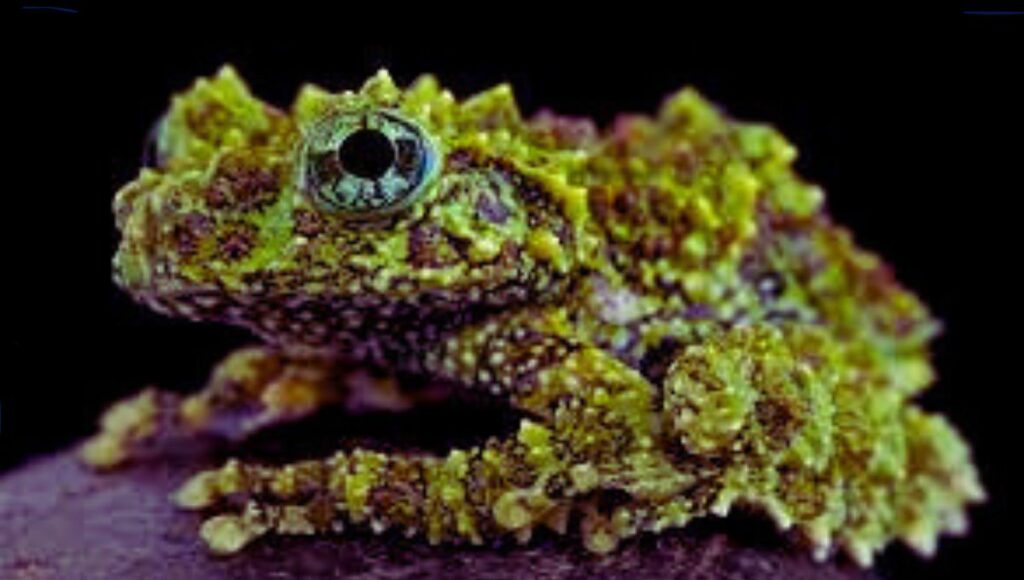
Vietnamese Mossy frogs can be poisonous to humans, dogs, cats, and other animals. The skins of Mossy frogs work as absorbent and help them to breathe. Not only does the skin absorb moisture from the environment but also absorbs chemicals and toxic substances from the surroundings. If you touch the frogs with a naked hand, it may cause skin irritations, rashes, and other skin problems. When a predator frightens Vietnamese Mossy frogs, the frogs curl into a ball-like structure and behave like they are dead.
Behaviour:
Vietnamese Mossy frogs are semi-aquatic, and nocturnal and show their arboreal nature. The frogs are not very active during the day and rest inside tree trunks, in shallow water, under rocks, in small caves, and in a heap of leaves. The frogs can also attach themselves to the floating plants on the stream’s surface. Mossy frogs show camouflage while resting to avoid their potential predators by appearing like moss growing on the rock and almost disappearing into the rocks covered with moss and waiting for prey.
Breeding and Vocalization:
Vietnamese Mossy frogs breed between April and June and during this season, males emit a melodious and quiet call to attract a female and show their fitness level. The attracted female and male mate through amplexus and the female lays eggs over floating plants, tree trunks, or rock caves where fresh water is available.
Hunting Technique:
Vietnamese Mossy frogs go to hunt in the evening and they sit silently on the rocks using their camouflage tricks. Mossy frogs almost disappear on the rocks because of their moss-like skin and when the prey comes closer to them, the frogs attack them efficiently.
Are Mossy frogs aggressive?
Vietnamese Mossy frogs are probably one of the nicest and least aggressive frogs. But if they are sick, they might show aggression to other frogs.
Can Mossy frogs jump and climb?
Vietnamese Mossy frogs have sticky toe discs that help them to show arboreal nature and they can climb trees easily. However, the frogs can jump due to their strong legs.
Diet:
Adult Vietnamese Mossy frogs are carnivorous but the tadpoles can consume algae too. Their diet consists of various insects such as spiders, crickets, waxworms, cockroaches, etc.
Predators and Threats:
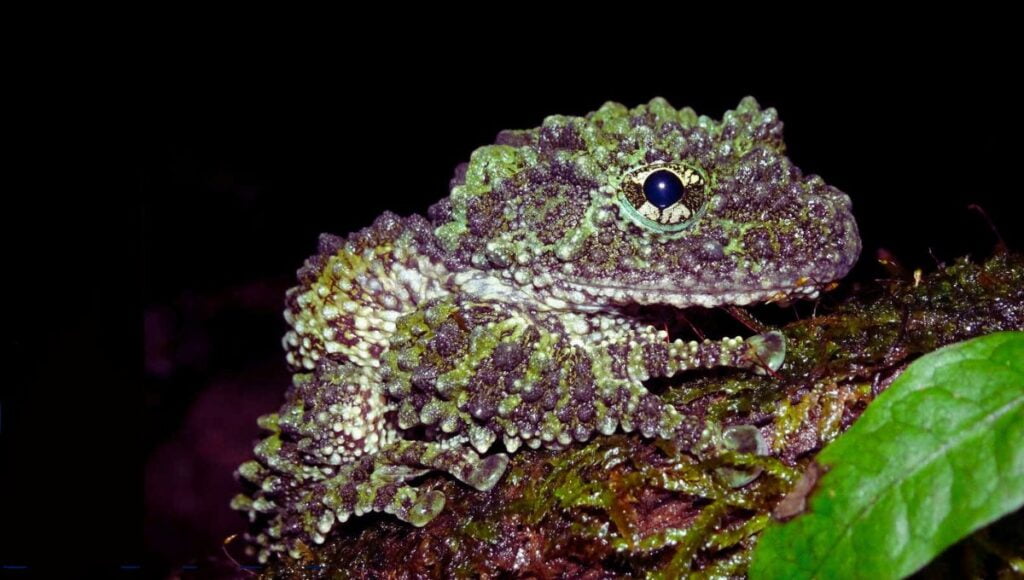
Snakes, larger birds, foxes, wild dogs, and cats are their main predators. However, Mossy frogs face many anthropogenic challenges such as deforestation. Expansion of agriculture, human settlements, increasing usage of pesticides and chemicals, and destruction of lakes and ponds in the region hurt Mossy Frog’s presence badly. However, due to their adorable appearances, Vietnamese Mossy frogs are victims of trafficking and poaching in the illegal pet market.
Conservation Status:
Vietnamese Mossy frogs are listed as “Least Concern” in the IUCN Red List of Threatened Species, however, their population in the wild is constantly decreasing.
Disease:
Like other frogs and amphibians, Mossy frogs are prone to be attacked by chytrid fungus that causes deadly skin disease to the frogs.
Lifespan:
In the wild, Vietnamese Mossy frogs reportedly live 5-7 years, and in captive care, they might live up to 12-15 years.
Are Vietnamese Mossy Frogs Good Pets for Beginners?
Vietnamese Mossy frogs can be very elegant, peaceful, and exotic pets for you but it all depends on your experience with frogs. The frogs can be very tricky for a beginner or hobbyist because Mossy frogs require a specific environment to survive. Being native to subtropical and evergreen rainforests, Mossy frogs require high humidity and a moderate temperature to thrive.
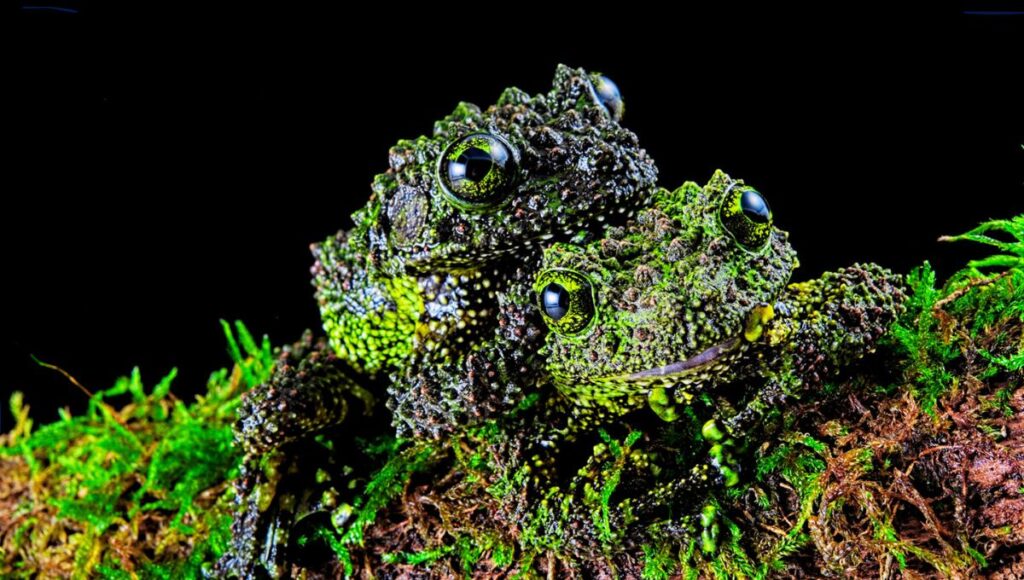
Vietnamese Mossy frogs are very docile and can be very afraid of human presence. If you can’t care for them properly, they’ll be stressed and curl into a ball and behave like they are dead. The Mossy frogs are not aggressive or noisy but they might show aggression to other frogs or amphibians if they are sick. Their skins work as absorbent and absorb chemicals and toxic substances from their surroundings. Hence, keep your kids away from touching the frogs and also use gloves while handling them.
Mossy frogs might not be the ones who will communicate with you very often but if you want a frog to watch their activities and entertain, Vietnamese Mossy frogs might be a good choice for you. Once you set up their habitat and specific environment, they are easy to care for, low maintenance, and won’t cause much trouble for the owner. However, the availability of healthy Mossy frogs in the pet market is questionable but if you find one, you can consider it as a pet.
How do you buy a Mossy frog?
It is advised not to buy any Vietnamese Mossy frogs from illegal pet markets because they are often illegally captured and unhealthy. This practice also promotes illegal trafficking and poaching of Mossy frogs. You can buy these frogs from a reputed breeder or pet shop that can ensure the frog is born and bred in captivity. Ask for proof of origin, health certificate, and other important details before purchasing.
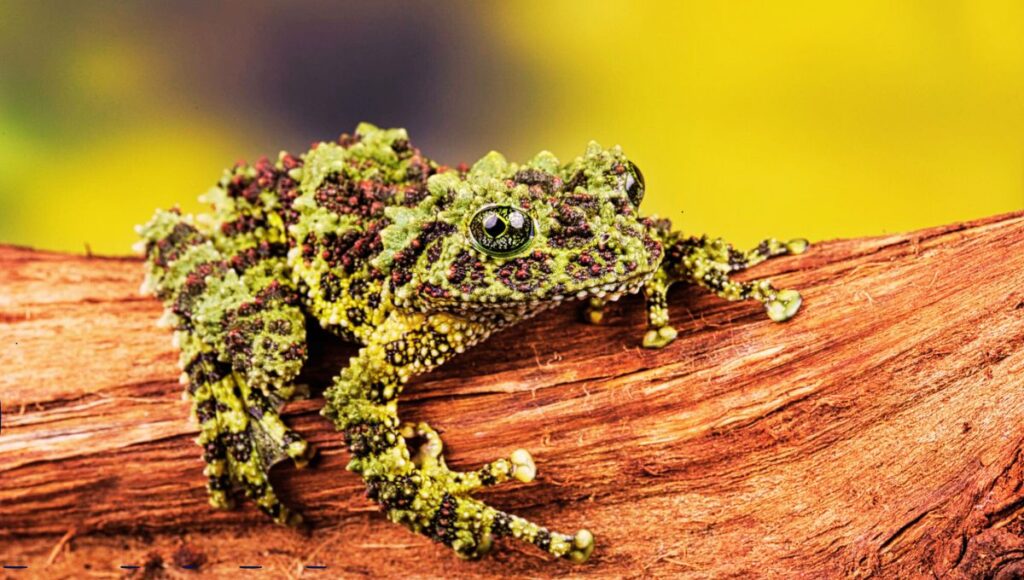
You must also check if it is allowed to keep Mossy frogs as pets or not based on your location. You can search online platforms for semi-aquatic amphibians, but check reviews, policies, and other important information before buying them.
The price of a Vietnamese Mossy frog mainly depends on the availability of the frogs. In the illegal pet market, you can find them at cheaper prices but there is a very high probability that they are not healthy frogs. A healthy Mossy frog bred in captivity may cost more than $70 depending on your location and availability.
Requirement and Care:
Vietnamese Mossy frogs can survive in captive care their whole life if you can set up their habitat and specific environment correctly and also fulfil every need and care for them properly.
Enclosure:
Vietnamese Mossy frogs don’t need a lot of space to thrive. You can put one or two frogs in a 10-gallon tank and a 20-gallon tank can easily become habitat for four to five Mossy frogs. You also need one or two water dishes, where the frogs can sit and drink water.
Mossy frogs are arboreal and hence they might try to escape. Thus your tank must have a solid lid and proper ventilation system. Place some live or artificial plants inside the tank that will provide a hiding place as well as help the frogs climb the trees. You need land and water portions separately in the tank as these frogs are semi-aquatic animals.
Can you keep two or more Vietnamese Mossy frogs in the same tank?
According to many reports, Vietnamese Mossy frogs don’t show cannibalism or don’t kill their own species and eat them. Hence, you can put two or more Mossy frogs in a container, just ensure that the tank is big enough. However, if a Mossy frog is sick only then they might show aggression, otherwise, they are very gentle and peaceful.
Can you keep other frog species with Vietnamese Mossy frogs?
It is never a great idea to keep two or more frog species in the same tank for two different reasons. Firstly, different frogs often attack each other and the stronger one kills and consumes the weaker one. Secondly, Most frogs secrete toxic substances from their body and it can harm the other frog species. Hence, it is advised not to keep your Mossy frogs with other frogs or amphibians.

Substrate:
Being native to subtropical and evergreen rainforests, Vietnamese Mossy frogs require a very high humid environment to thrive. You can use any natural or artificial substrate that can hold moisture but is not toxic. Peat, green moss, sphagnum moss, coco fibre, or natural cork bark (eg. orchid), can be good options as a substrate to be used in the land portion. However, for the water portion, you should use medium-sized rocks or gravel (that the frogs can’t swallow), a mixture of soils, etc can be used if you are planning to plant live plants there.
Temperature and Humidity:
Vietnamese Mossy frogs require low-medium temperatures to thrive. The preferable temperature for Mossy frogs is 60-70 degrees Fahrenheit but they can also survive in low temperatures such as 50 degrees Fahrenheit. Any temperature beyond 75 degrees Fahrenheit is dangerous for the semi-aquatic arboreal frogs. Remember, it is easy to warm the tank but it’ll be very difficult and costly to cool the tank. Thus, choose the coldest place at your home for the Mossy frogs rather than a warm place.
Evergreen rainforests receive a huge rainfall throughout the year and hence Vietnamese Mossy frogs survive in highly humid conditions (75-100% humidity). Ensure the ventilation is proper and sprinkle water several times a day to maintain the humidity level. Or, if you don’t have enough time use a fogger or mist maker to maintain the humidity. Also, it is advised to use a thermometer and hygrometer to monitor the temperature and humidity level of the enclosure as it is very important for Mossy frogs.
Lights:
A 12-hour day-night circle is very important for these frogs to regulate their daily activities. In this case, you can use low-wattage fluorescent bulbs or UVA/UVB lights. UVA/UVB lights provide the frogs with a small quantity of vitamin D that they don’t receive from sunlight.
Food and Water:
The amount of food a Mossy frog needs depends on its age, sex, gender, health conditions, and appetite level. However, it is important to know that due to low temperatures, these frogs have very low metabolism rates and they only need 8-10 insects a week. However, you can feed the tadpoles in a small amount daily.
You should feed the adult Vietnamese Mossy frogs 4-5 gut-loaded insects every three days. Gut-loaded crickets, waxworms, mealworms, cockroaches, and superworms can be good sources of nutrition for your frog. Once a week, dust the foods with vitamin and calcium supplements to provide them with proper vitamins and calcium. Use only dechlorinated water to feed them. However, change 50% of the water daily and refill with fresh water.
Cleaning:
You must clean the water dish, waste food, and dead insects inside the enclosure regularly to prevent any kind of bacterial or fungus growth. Once a month deep clean the tank with mild disinfectant and rinse it thoroughly with dechlorinated water. Also, change the substrate if it smells bad or change it every 10-12 weeks.
Handling:
Unfortunately, Mossy frogs don’t like human touches and hence it is advised not to touch them unless it is too necessary. Unnecessary touches can make them stressful and a stressed frog live less than normal frogs. Hence, keep your kids away from the frogs if they touch the Vietnamese Mossy frogs for fun.
Additionally, the skins of Vietnamese Mossy frogs can be very toxic sometimes, and hence wear gloves before touching them and wash hands with soap after that. You can feed them with a soft-tipped tong and when you touch the frogs ensure your gloves are wet.
Please try to respect your frog’s personal space and make them feel comfortable without bothering them unnecessarily. With proper care and nutrition, a Vietnamese Mossy frog can live up to 15 years in captive care.
Reference: Wikipedia
Also Read: Are Barking Tree Frogs Good Pets for Families or Beginners? A Perfect Pet Guide
Also Read: Are Mikado Pheasants Good Pets?